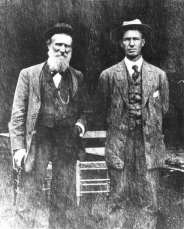the john muir exhibit - people - william kent
William Kent
1864-1928

- Businessman,
Rancher, Philanthropist and U.S. Congressman (between 1911 and 1917).
- William Kent
and his wife, Elizabeth Thacher Kent, bought 295 acres (the deed was in both their names) along Redwood
Creek in Marin County for $45,000 in 1905. To protect the beautiful
stands of redwoods located there, the Kents donated the land to
the United States Federal Government. In 1908, President Theodore
Roosevelt declared the donated land Muir Woods National Monument.
Roosevelt had suggested naming the area after Kent, but the Kents
requested that it be named for conservationist John Muir.
- John Muir wrote to Wiliam Kent regarding the establishment of Muir
Woods National Monument saying, "Seeing my name in the tender & deed of the Tamalpais Sequoias was a surprise of the pleasantest kind. This is the best tree-lover's monument that could possibly be found in all the forests of the world. You have done me great honor, & I am proud of it... Saving these woods from the axe & saw, from money-changers and water- changers & giving them to our country & the world is in many ways the most notable service to God & man I've heard of since my forest wanderings began."
- When serving
as a U.S. Congressman (1911-1917), Kent disagreed with Muir on
the fate of Hetch Hetchy Valley,and was a key proponent of the 1913 legislation creating the Hetch-Hetchy Reservoir, a stance that ultimately cost him his personal friendship with John Muir, who Kent would call "a man entirely without social sense." See Hyde, Anne F. (1994). "William Kent: The Puzzle of Progressive Conservationists". California Progressivism Revisited: 35–53. ISBN 9780520084704.
- Later, Kent co-introduced legislation
establishing the National Park Service, which passed Congress in 1916.
- His memory is, however, marred by many backward ideas he brought to Congress, such as his efforts to exclude Chinese and Japanese immigrants from the United States and policies that barred Asian immigrants from owning land or becoming U.S. citizens. John Muir did not share Kent's anti-Asian animus, as he worked alongside the Chinese immigrant workers to plant and harvest hundreds of tons of fruit each year on his Martinez ranch, and most meals in his home were prepared by Chinese cook Ah Fong, who worked for the Muir family for many years. Similarly, in May 2014, a young native Japanese student, Ryozo Azuma, spent 3 days with Muir; "Three of the most important days of his life" talking mountains, conservation, and Alaska. Muir arranged for a Captain Hooper to take Ryozo on as crewman on his revenue cutter bound for Alaska and adventure. Over the years, Azuma would climb over 140 mountains, become Japan's leading expert on the Arctic, save the life of the Norwegian explorer Roald Amundsen, become known as the "John Muir of Japan," and write a biography of Muir in the Japanese language. Today, the John Muir National Historic Site celebrates Asian-Pacific American Heritage Month every May.
Photo of John Muir (left) and William Kent at
Muir Woods Inn, circa 1909, courtesy Muir Woods National Park Service
Collections.
Home
| Alphabetical Index
| What's New & About this Site